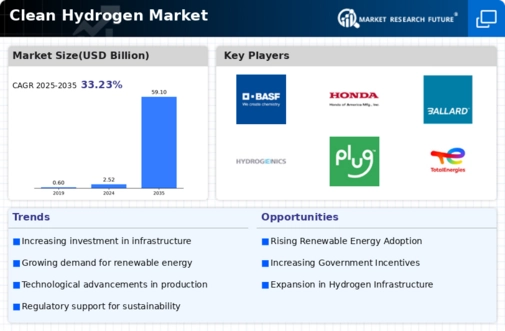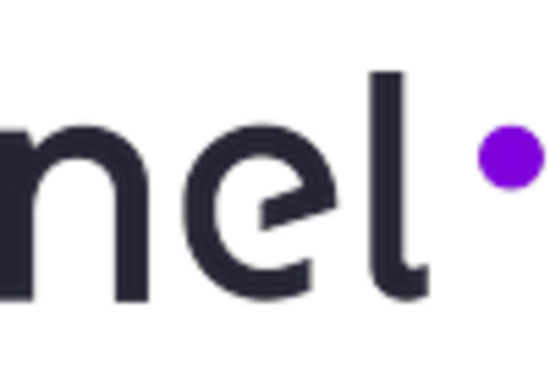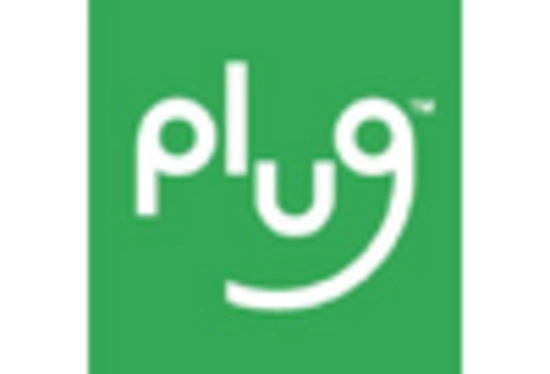Rising Global Energy Security Concerns
Concerns regarding energy security are increasingly influencing the Clean Hydrogen Market. As nations seek to diversify their energy sources and reduce dependence on fossil fuels, hydrogen is emerging as a strategic alternative. The volatility of fossil fuel prices and geopolitical tensions have prompted governments to explore hydrogen as a means to enhance energy independence. Recent analyses suggest that hydrogen could play a critical role in stabilizing energy supply chains, particularly in regions heavily reliant on imported fossil fuels. This shift towards hydrogen is likely to be supported by investments in infrastructure and technology development, aimed at creating a robust hydrogen economy. As a result, the Clean Hydrogen Market may experience accelerated growth, driven by the need for secure and sustainable energy solutions.
Growing Interest from Industrial Sectors
The Clean Hydrogen Market is witnessing increasing interest from various industrial sectors, particularly those with high energy demands and carbon footprints. Industries such as steel, cement, and chemicals are exploring hydrogen as a means to decarbonize their operations. For instance, the steel industry is projected to account for approximately 7% of global carbon emissions, prompting companies to seek cleaner alternatives. Recent studies indicate that transitioning to hydrogen-based processes could reduce emissions by up to 90%. This growing interest is likely to drive investments in hydrogen technologies and infrastructure, as industries aim to meet sustainability targets and regulatory requirements. Consequently, the Clean Hydrogen Market stands to benefit from the industrial sector's shift towards cleaner energy solutions, potentially leading to increased market penetration and growth.
Increasing Demand for Clean Energy Solutions
The Clean Hydrogen Market is experiencing a notable surge in demand for clean energy solutions. This trend is driven by a growing awareness of climate change and the need for sustainable energy sources. As industries and governments strive to reduce carbon emissions, hydrogen is emerging as a viable alternative to fossil fuels. According to recent estimates, the demand for clean hydrogen is projected to reach 10 million tons by 2030, indicating a robust growth trajectory. This increasing demand is likely to propel investments in hydrogen production technologies and infrastructure, thereby enhancing the overall market landscape. Furthermore, the Clean Hydrogen Market is expected to benefit from the transition towards electrification in various sectors, including transportation and manufacturing, which may further augment the demand for hydrogen as a clean energy carrier.
Supportive Government Policies and Incentives
Government policies and incentives are crucial drivers for the Clean Hydrogen Market. Many countries are implementing supportive frameworks to promote the adoption of clean hydrogen technologies. For example, various nations have introduced subsidies, tax incentives, and grants aimed at encouraging investments in hydrogen infrastructure and research. Recent policy initiatives indicate that governments are allocating substantial funding towards hydrogen projects, with some countries committing over 10 billion dollars to develop hydrogen ecosystems. This financial backing is expected to stimulate growth in the Clean Hydrogen Market, as it lowers the barriers to entry for new players and encourages existing companies to expand their hydrogen-related operations. Furthermore, these policies often align with broader climate goals, reinforcing the importance of hydrogen in achieving net-zero emissions targets.
Advancements in Hydrogen Production Technologies
Technological advancements play a pivotal role in shaping the Clean Hydrogen Market. Innovations in hydrogen production methods, such as electrolysis and steam methane reforming, are enhancing efficiency and reducing costs. For instance, the development of renewable energy-powered electrolysis systems is enabling the production of green hydrogen, which is gaining traction among industries seeking to decarbonize. Recent data suggests that the cost of producing green hydrogen could decrease by up to 50% by 2030, making it a more competitive option compared to traditional fossil fuel-based hydrogen. These advancements not only improve the economic viability of hydrogen production but also contribute to the overall sustainability goals of various sectors. As a result, the Clean Hydrogen Market is likely to witness increased adoption of innovative technologies that facilitate cleaner and more efficient hydrogen production.

















Leave a Comment